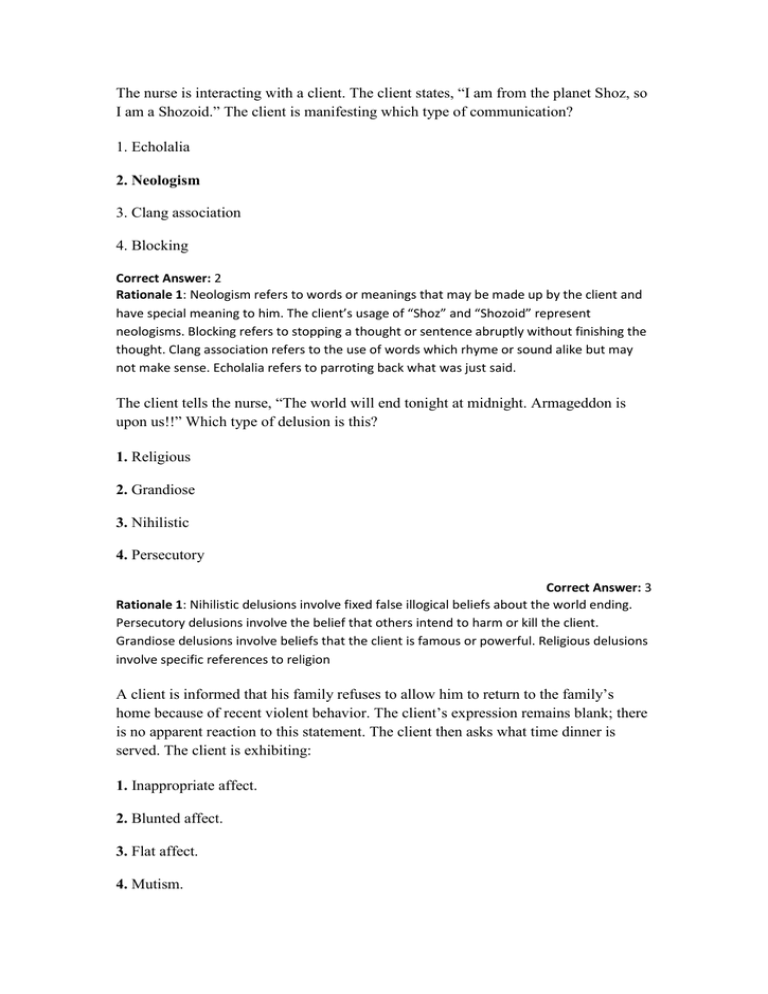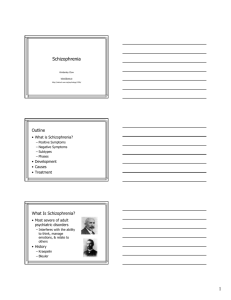quiz key
advertisement

The nurse is interacting with a client. The client states, “I am from the planet Shoz, so I am a Shozoid.” The client is manifesting which type of communication? 1. Echolalia 2. Neologism 3. Clang association 4. Blocking Correct Answer: 2 Rationale 1: Neologism refers to words or meanings that may be made up by the client and have special meaning to him. The client’s usage of “Shoz” and “Shozoid” represent neologisms. Blocking refers to stopping a thought or sentence abruptly without finishing the thought. Clang association refers to the use of words which rhyme or sound alike but may not make sense. Echolalia refers to parroting back what was just said. The client tells the nurse, “The world will end tonight at midnight. Armageddon is upon us!!” Which type of delusion is this? 1. Religious 2. Grandiose 3. Nihilistic 4. Persecutory Correct Answer: 3 Rationale 1: Nihilistic delusions involve fixed false illogical beliefs about the world ending. Persecutory delusions involve the belief that others intend to harm or kill the client. Grandiose delusions involve beliefs that the client is famous or powerful. Religious delusions involve specific references to religion A client is informed that his family refuses to allow him to return to the family’s home because of recent violent behavior. The client’s expression remains blank; there is no apparent reaction to this statement. The client then asks what time dinner is served. The client is exhibiting: 1. Inappropriate affect. 2. Blunted affect. 3. Flat affect. 4. Mutism. Correct Answer: 3 Rationale 1: Flat affect is defined as a total lack of emotion or expression. The client does not appear to display inappropriate or incongruent affect. Blunted affect is defined as having a minimal emotional response to a person or event. Mutism is defined as an inability or refusal to speak when able to do so. A client tells the nurse, “I refuse to take quetiapine (Seroquel) because it is manufactured by Al Qaeda. If I take it, I’ll die.” This is an example of: 1. A negative symptom of schizophrenia called alogia. 2. A negative symptom of schizophrenia called avolition. 3. A positive symptom of schizophrenia called delusion. 4. A characteristic of schizophrenia called ambivalence. Correct Answer: 3 Rationale 1: The client’s statement is an example of the positive symptom of schizophrenia called delusion, which is a mistaken or false fixed belief about the self or the environment. The client’s statement is not an example of ambivalence which is defined as concurrent conflicting emotions, thoughts, or actions toward a person, object, or concept. It is also not an example of the tendency to use minimal words to speak called alogia, or of a lack of motivation called avolition. A client talks in a monotone voice and shows no emotion when speaking. The client tells the nurse, “I want to stay in bed all day. I do not enjoy watching television like I used to. I do not want to talk with other people.” Which of the following symptoms of schizophrenia are illustrated in this scenario? 1. Alogia 2. Flat affect 3. Anhedonia 4. Avolition 5. Apathy Correct Answer: 2,3,4,5 Rationale 1: Alogia. The client is speaking in full sentences. Alogia is the tendency to use minimal words to speak. Rationale 2: Flat affect. The client is speaking in a monotone voice and shows no emotion, fitting the definition of flat affect. Rationale 3: Anhedonia. The client states it is no longer enjoyable to watch television. Anhedonia is defined as the lack of interest in normally pleasurable activities. Rationale 4: Avolition. The client wants to remain in bed, exhibiting a lack of desire to engage in activities. Rationale 5: Apathy. The client’s statement about not wanting to talk to other people indicates feelings of indifference toward events and people. Which of the following behaviors is characteristic of a client with disorganized schizophrenia? 1. A client tells the nurse he is being “monitored” by the FBI. 2. A client tells the nurse, “All is well, but the well is dry, so why bother with clock and tock, mock, lock, jock.” 3. A client comes to the nursing station and asks for something to “help calm my nerves.” 4. A client sits in the corner rocking back and forth crying because “the voices are telling me I am a lousy good-for-nothing.” Correct Answer: 2 A statement which accurately describe genetics and schizophrenia would be: 1. One single gene is responsible for producing schizophrenia. 2. There is strong evidence that environmental factors do not affect the risk of developing schizophrenia. 3. 10% of first degree relatives (children, siblings, parents) are diagnosed with schizophrenia at some point in their lives. 4. The chance of monozygotic (identical) twins both having schizophrenia is 100%. Correct Answer: 3 Which of the following statements that address the typical age of onset for schizophrenia is true? 1. The typical age of onset for schizophrenia is early adolescence in both males and females. 2. The typical age of onset for late-onset schizophrenia is age 60. 3. The typical age of onset for schizophrenia is late adolescence to mid-thirties. 4. The typical age of onset for schizophrenia is late thirties to early forties. Correct Answer: 3 A client is pacing in the hall. The nurse overhears the client say, “Leave me alone. I am not in the Mafia.” The best response from the nurse would be: 1. “Remember you are safe from the Mafia here in the hospital.” 2. “Tell me what you are hearing right now.” 3. “You need to attend the next recreation group. That will help you ignore the voices.” 4. “You are hearing voices again, right?” Correct Answer: 2 Rationale 1: “Tell me what you are hearing right now” is an open statement that allows the client to inform the nurse what is being experienced. The nurse does not presume to know what the client is experiencing. “You are hearing voices again, right?” presumes to know what the client is experiencing without asking the patient directly. “You need to attend the next recreation group. That will help you ignore the voices” does not ask for an explanation of the client’s experiences and implies that a client can ignore voices. “Remember you are safe from the Mafia here in the hospital” does not ask for an explanation of the client’s experiences, so may not be addressing the client’s needs at this time. This is an example of false reassurance The sister of a client with schizophrenia asks the nurse what to do when her brother “acts like he is talking to someone, but no one is there.” Which of the following responses by the nurse would help the sister gain insight into her brother’s experience? 1. Tell your brother to go to his room to decrease the amount of stimuli he is experiencing. 2. Tell your brother there is no one else in the room. 3. Give your brother medication for increased anxiety. 4. Ask your brother to describe what he is seeing and hearing Correct Answer: 4 Rationale 1: Asking your brother to describe what he is seeing and hearing serves to not only ask the client for information, but also helps validate the client’s experiences. The other statements fail to ask the client what is being experienced. Telling your brother there is no one else in the room is phrased incorrectly. A better response would be for the sister to state, “I do not see anyone else in the room. Tell me what you see and hear.” Telling your brother to go to his room to decrease the amount of stimuli he is experiencing does not address what the client is experiencing. There is no indication the client is experiencing increased anxiety. Additionally, giving medication would not help the sister gain insight into her brother’s experience.



